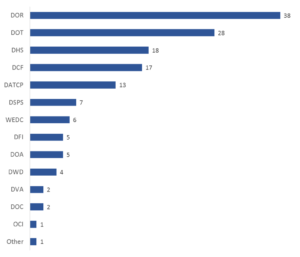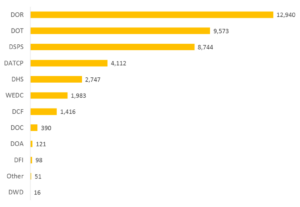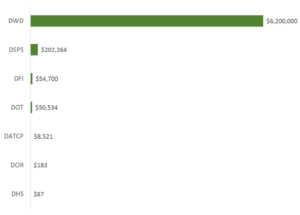A PDF of this policy paper can be found here.
Before Governor Scott Walker took office in 2011, Wisconsin was in need of regulatory reform and improving the state’s economic climate. According to Wisconsin Manufacturers & Commerce (WMC), the state chamber, before Governor Walker took office,
- “…Wisconsin CEOs report[ed] the state’s business regulations are out of line, hamper job creation, and are in need of major reforms…”1
- “…Ninety-four percent said Wisconsin rules regulate more than what is necessary to achieve stated policy objectives…”1
- “…Seventy-two percent state[d] rules hamper employee retention and 92 percent report Wisconsin regulations burden the company…”1
When Governor Walker and a reform-minded legislature took office, he quickly proposed bold regulatory reforms that could help Wisconsin’s business leaders that had been negatively impacted by burdensome state regulations. By proposing “business-friendly reforms,”2 such as regulatory reforms, “…[Governor] Walker’s words and actions have resonated in the business community both here and nationally…”2 and the state would see important job creation efforts over his tenure. As noted in a WMC column dated July 11th, 2011,
“…88 percent of Wisconsin business leaders said they are confident the state is heading in the right direction, up from just 10 percent a year ago. That’s good news because confident businesses hire. Pessimistic ones don’t…”2
As states are looking to limit the growth of bureaucracy, eliminate waste, fraud, and abuse in government spending, improve their bottom lines, and create a business climate that leads to jobs and economic growth, Wisconsin offers a wide range of legislative and executive actions as examples.
Legislative Efforts on Regulatory Reform
On January 18th, 2011, at the request of Governor Walker and then-Rep. Thomas Tiffany (R-Minocqua), the Assembly Organization introduced January 2011 Special Session Assembly Bill (AB) 8.3 This legislation made several changes to state agencies and their authority on administrative rules. For instance,
“…Act 21 provides that no agency may implement or enforce any standard, requirement, or threshold, including as a term or condition of any license issued by the agency, unless that standard, requirement, or threshold is explicitly required or explicitly permitted by statute or by rule…”4
During the 2013-14 Legislative Session, the State Assembly further continued these regulatory reform efforts as part of their “Right the Rules” initiative. In fact, the Wisconsin Assembly decided to examine Wisconsin’s 1,768 chapters of administrative code, which encompassed roughly 11,764 pages of agency regulations.5 This legislative effort was historic because it was “…believed to be the first such regulatory review in Wisconsin’s history…”5 and “…the goal [was] to eliminate regulations that restrict job growth and aren’t essential to public or environmental protection…”5
On January 26th, 2017, Wisconsin legislators also introduced Senate Bill 15 and AB 42.6 When this legislation was published into law in August of 2017, “…Wisconsin became the first state in the nation to adopt its own version of the REINS Act (hereinafter WI REINS Act), which requires legislative approval of any rule with compliance costs exceeding $10 million…”7 At the federal level, elected officials are still trying to pass the REINS Act. Most recently, it was reintroduced on January 10th, 2019 as S. 92 – Regulations from the Executive in Need of Scrutiny Act of 2019.8
All of these legislative efforts were designed to remove burdensome agency regulations that negatively impacted businesses in Wisconsin by leaving them mired in bureaucratic red tape and inefficient state agency processes.
Governor Walker’s Initiatives to Address Waste, Fraud, and Abuse in Government Programs
Rolling back government regulation also had the effect of saving taxpayers money and improving the way state government functions. Shortly after Governor Walker took office, on January 3rd, 2011, Executive Order #2 created the Governor’s Commission on Waste, Fraud and Abuse.9 Waste, fraud, and abuse within government spending did not help Wisconsin’s fiscal situation of being “…one of the nation’s 10 states in the most perilous fiscal condition…” and Wisconsin seeing a “…biennial budget…[increase] 33 percent to $62 billion during Governor Doyle’s two terms in office…”9 As noted in 2011 Executive Order #2, the evidence of waste, fraud, and abuse in government spending included:
- “…According to figures released by the Wisconsin Department of Workforce Develop- ment, fraudulent unemployment insurance claims rose from $4.7 million in 2007 to $17.7 million in 2009…”9
- “According to a report by the Wisconsin Legislative Audit Bureau, fraud in the Wiscon- sin Shares child care program cost the state $20 million in 2008…”9
- “In 2007, the Department of Health Services announced that an upgrade of the state’s computer system that processes claims for BadgerCare, SeniorCare and other Medicaid programs was 39,000 worker hours behind schedule and at least $9.3 million over bud- get – 28.8% more than the original projections…”9
Governor Walker continued to address excessive government spending in several Executive Orders such as:
- 2011 Executive Order #5, which “…require[d] cabinet secretaries to hold regular meetings with frontline workers in order to help identify efficiencies and cost sav- ings…”10
- 2011 Executive Order #7, which “…require[d] that the appointed heads of each administrative department and independent agency create a team within their depart- ments and agencies to assist the Commission on Waste, Fraud and Abuse to identify waste, fraud and abuse within each agency and recommend steps to eliminate waste, fraud and abuse…”11
Wisconsin was changing how state government operated and these reforms created results. In 2012, the Commission on Waste, Fraud and Abuse published a report “…detailing more than $370 million in potential savings to the state…”12 As noted by the Milwaukee Journal Sentinel,
- “…Efforts to combat tax fraud and increase collections have shown results. Overall, anti-fraud collections are up $74 million, based on figures published by the state De- partment of Revenue…”12
- “…Similarly, anti-fraud efforts in state welfare programs have brought in $48 million more…”12
- “…The commission’s report talked about ways to get state agencies to return, or ‘lapse,’ unspent funds back to the state treasury… we think $112 million better reflects true sav- ings in that category…”12
- “…Walker went after fraud in the state’s Wisconsin Shares child-care program, the subject of the ‘Cashing in on Kids,’ investigation by the Milwaukee Journal Sentinel. We documented $44 million in cost savings there for 2012-13 alone…”12
- “…Add in a $37 million increase in collection of overpayments of unemployment insur- ance benefits, and the total savings tops $300 million…”12
Wisconsin’s Lean Government Programs
While Governor Walker was keeping his promise to deliver hundreds of millions of dollars in savings on government spending, he also chose to implement lean initiatives in state government. Lean initia- tives have been long used in the private sector to maximize quality and minimize waste. This initiative was the focus of 2012 Executive Order #66, which directed Governor Walker’s agencies to implement “Lean Government” initiatives to:
“…eliminate waste, save time, standardize workflow, and decrease process complexity… [e]stablish measurement criteria for the services the agency performs with a focus on processes that…[r]educe workload, improve customer satisfaction, and improve processes…”13
The first year of this initiative saw tremendous results. For example, “…the lean-government initiative eliminated 400 unneeded bureaucratic steps in state regulatory agencies, saved nearly 80,000 staff hours, reduced regulatory backlogs by an average of 54% and saved $1.6 million…”14
In the 2015-17 Biennial Budget, Governor Walker proposed the creation of the “…Office of Lean Government to enhance Lean initiatives to find efficiencies across all state agencies…”15 This Department of Administration program established a mission statement “…to solve problems in Wisconsin state agencies that cause frustration, consume time, or result in unnecessary costs…”16 and services listed on the program’s website include “[t]raining state employees…” and “…[l]eading improvement efforts…”17
In Fiscal Year 2018, the Lean Government Program posted metrics that demonstrated the positive results of this initiative that implemented “…147 improvement efforts completed statewide…”18 The metrics included:
- “Annual hours repurposed: 42,191 hours”18
- “Annual cost saved: $6,516,289”18
- “Annual cost avoided: $16,342”18
- “One-time cost savings: $121,392”18
Making state agencies run lean not only saved taxpayers money. Like other legislative and executive actions, it meant fewer ways that burdensome regulations could stand in the way of businesses trying to grow. The Lean Government Program’s website highlights the following visual representation of key results by agency:
Number of Improvement Efforts Completed by an Agency18

Annual Hours Repurposed by an Agency18

Annual Cost Saved by Agency18

What Can Other States Learn from Wisconsin?
As other states and the federal government are trying to keep the economy growing and control government spending, Wisconsin provides an excellent example of regulatory reforms that states can implement. In a 2015 op-ed, Governor Walker highlighted the reason for his reforms and the reasoning for why Wisconsin is an example for other states. As he said,
“…Reforming our bloated federal government is essential to revitalizing our nation’s economy, and I like to think what we have been doing in Wisconsin could serve as
a model…I look at unnecessary regulations as irrational taxes that hinder economic growth. Reforming the burdensome regulatory system acts as a tax cut—encouraging entrepreneurs and small business owners and putting money into the hands of consumers. Simple changes allow businesses to focus more on growth than on regulations…”13
Wisconsin has seen the positive results of these reforms, from greater business growth to taxpayer savings to a better functioning state government. If other states want to institute bold reforms, they simply need to look to the Dairy State for reforms that work.
Endnotes
1 https://www.wmc.org/news/press-releases/wisconsin-ceos-say-state-regulations-overly-burden-some-hamper-jobs/
2 https://www.wmc.org/news/press-releases/wmc-column-wisconsin-is-heading-in-the-right-direction/
3 https://docs.legis.wisconsin.gov/2011/proposals/jr1/ab8
4 https://docs.legis.wisconsin.gov/2011/related/lcactmemo/act021.pdf
6https://docs.legis.wisconsin.gov/2017/proposals/sb15
7 https://www.wisbar.org/NewsPublications/WisconsinLawyer/Pages/Article.aspx?Volume=91&Is- sue=9&ArticleID=26622
8 https://www.congress.gov/bill/116th-congress/senate-bill/92
9 https://docs.legis.wisconsin.gov/code/executive_orders/2011_scott_walker/2011-2.pdf
10 https://docs.legis.wisconsin.gov/code/executive_orders/2011_scott_walker/2011-5.pdf
11 https://docs.legis.wisconsin.gov/code/executive_orders/2011_scott_walker/2011-7.pdf
12 https://www.politifact.com/wisconsin/promises/walk-o-meter/promise/857/identify-300-million-waste-fraud-and-abuse-state-b/
13 https://docs.legis.wisconsin.gov/code/executive_orders/2011_scott_walker/2012-66.pdf
14 https://www.realclearpolitics.com/articles/2015/07/02/welcome_to_wisconsin_mr_president_127211.html
15 https://doa.wi.gov/budget/SBO/2015-17%20Executive%20Budget%20Complete%20Document.pdf
16 https://lean.wi.gov/Pages/AboutUs/MissionAndPrinciples.aspx
17 https://lean.wi.gov/Pages/AboutUs/Services.aspx
18 https://lean.wi.gov/Pages/Results/Metrics.aspx
